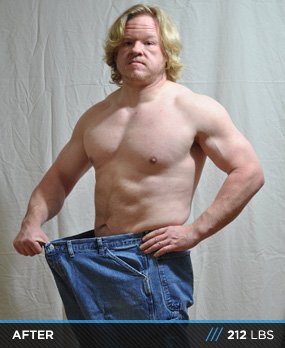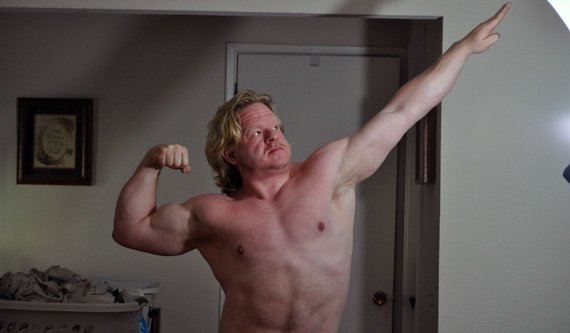 |
 |
| AGE 34 HEIGHT 5'8" WEIGHT 292 lbs BODY FAT 50% WAIST 52.5" |
AGE 36 HEIGHT 5'8" WEIGHT 212 lbs BODY FAT 13% WAIST 36.8" |
Why I Got Started
In January of 2010, I came to the crushing realization that I was morbidly obese, and on the fast road to an early grave. I felt horrible, slept poorly, struggled to function throughout the day, got winded climbing two flights of stairs, was constantly irritable, and generally felt like a 90-year-old man.
On top of this, when I saw photos of myself, I would be depressed for days. I hated how I looked, and in turn, started to hate myself.
I came to the conclusion that something had to be done. Furthermore, it had to be done quickly, because at the rate I was going, the time was coming soon where I would not be able to reverse the damage. So, I decided to attack the problem with everything I had.
How I Did It
Initially, I knew I wanted to gain muscle more than anything else, and I knew from past experience that I wouldn't do that by trying to follow what pro bodybuilders did.
See, in high school, I took weightlifting, and the coach had us do a simple 5x5 program (which was actually the Texas Method, though I didn't know this at the time).
In the 6 months I was in weightlifting, I gained more mass than I had in the previous 4 years of trying to copy routines from magazines. When I started back, I remembered this, and decided that I would try to find the best 5x5 program there was, and would follow it to the letter.
My search led me to Bodybuilding.com, where I chose Madcow's Intermediate, as laid out here:www.bodybuilding.com/fun/wotw56.htm. Little did I know that this was a modified version of the original program, but it didn't matter, this is what I went with.
In 6 months I made enormous gains in strength and size, taking my bench to 310 x 5 and my squat to 360 x 5.
However, while my effort under the bar was paying dividends in strength and size, my lack of effort at the table was showing through. In July of 2010, I still weighed over 280 pounds and had a 48.5-inch waist. Thus, I began to correct that side of the equation.
Initially, I began by trying to out-exercise my diet, which as most people know, is an exercise in futility. I added 40 miles per week of recumbent biking, keeping my heart rate steady at 130bpm. I only made minor changes to my diet, such as beginning to consume whey protein shakes regularly.
By November of 2010, my weight had dropped to 268, but there it stalled. At this point, I knew I needed to step things up. I found the original Madcow's 5x5 program and switched to it, and started experiments with Ketogenic dieting, using a Cyclical Ketogenic Dieting approach based on Lyle McDonald's articles.
Ketogenic dieting had worked for me in the past, so I had hoped that there truly was a metabolic advantage to the diet and it would work better for me than standard caloric restriction.

Obese is no longer associated with Brian after he lost 65 pounds.
Unfortunately, all I did during this period is prove to myself that calories are the key to success while dieting, regardless of diet style. After three months of no progress on the ketogenic diet, I purchased a Bodymedia FIT and began using it to help me determine how many calories I should be eating based on my activity levels.
This, for me, was the absolute turning point in my weight loss. I made sure to eat 1000 calories per day less than I burned, every day, and the fat began falling off. One year later I had dropped 65 more pounds and reached the condition in my after photos.
Suggestions For Others
First and foremost, if you are looking to learn, always look for something backed by science before anecdote. Science certainly doesn't have all of the answers, but it's almost always a good place to start.
Second, learn to think like a scientist. If you learn how to analyze data scientifically, you will have much less trouble avoiding the glut of misinformation that is coming at you from the Internet.
For more specific recommendations, here are some basics, split into diet, supplementation, and training:
- There are no shortcuts or silver bullets. Success takes work. Accept that and resolve to work hard and you will notice that you are no longer paralyzed by fear of 'doing the wrong thing.'
- Be consistent!
- You do not have to measure everything and count calories to be successful. But if you find yourself unable to succeed, and you are not doing those things, how are you going to know what you need to change?
- Quit worrying about starvation mode. If you adjust your diet correctly, eat enough protein, lift heavy, and don't get greedy with cardio you will be fine.
- Hunger is nothing to be afraid of. It goes away. You aren't going to starve to death if you don't have that cookie.
- Give intermittent fasting a shot, especially if you are overweight and like to eat a lot at one sitting.
- If you can't put on mass, you aren't eating enough.
- Dieting, whether losing or gaining weight is simple. But that doesn't mean it's easy. See the first point above.
- There is no magic or evil macronutrient. They are all good in the correct quantity.
- I suggest that everyone read everything they can find by these guys:
- :
Martin Berkhan
- :
Alan Aragon
- :
The Spartan Warrior
- :
- It's OK to experiment, but be careful.
- Supplementation is not necessary to get to 90% of your potential. A good diet, training program, and work ethic will get you that. Supplementation can make this happen a little faster, but only marginally, and only if everything else is already in good shape.
- Here's some good sites for solid supplement info:
- :
- :
- There are no shortcuts or silver bullets. Success takes work. Accept that and resolve to work hard and you will notice that you are no longer paralyzed by fear of 'doing the wrong thing.'
- Try to avoid 'program hopping' as much as possible. You cannot measure progress if you are constantly changing things. Give each program you try a sufficient amount of consistent effort before calling it a failure.
- If you want to get stronger, you have to keep adding weight to the bar as often as possible.
- I suggest that you base the majority of your effort around heavy, compound lifts (press, squat, deadlift, etc.). They provide the best bang (training stimulus) for your buck (time).
- I suggest you avoid machines if possible.
- I suggest you avoid smith machines like the plague.
- Learn how to perform each lift with proper form. Drop the weight down while you do so. Check your ego until you have form nailed.
- Video yourself and learn to analyze your own form.
- Use the full range of motion.
- I suggest everyone, regardless of ability, buy and read Starting Strength by Mark Rippetoe. It's hard to believe that there's anyone who won't get some benefit from it.
- Everything works at first. Everything quits working eventually. There's no hard and fast rule for when things switch from one to the other.
- Rest is important. Do not avoid your deloads, and don't cheat on them. Let easy days be easy.
- For me, alcohol is the enemy of hypertrophy. I would suggest that you moderate your intake according to your goals.
Thanks And Credits
Special thanks to my wife, Beth, for putting up with my brand of obsessiveness, and for the after pictures.

